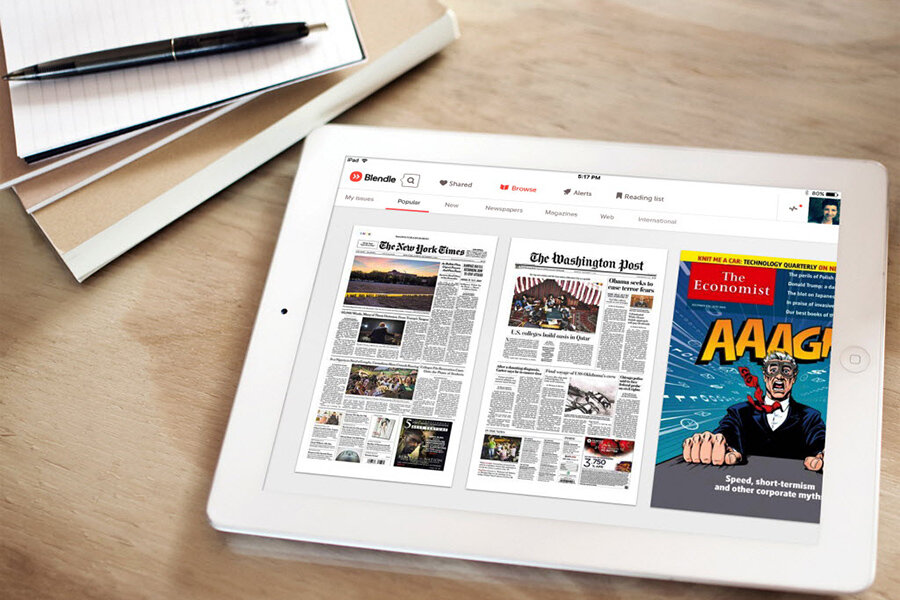Blendle: Can an 'iTunes for journalism' save the industry?
A Dutch startup called Blendle hopes that millennials who don’t want to pay for subscriptions to newspapers and magazines will be willing to pay a few cents per story instead, thereby helping to prop up an industry that has been on the brink of collapse virtually since the dawn of the Internet.
On Wednesday, the 2-year-old company launched a beta version of its service in the United States, available for now to 10,000 users. It comes here flush with content from 20 publishers, including The New York Times, The Wall Street Journal, the Economist, and Fast Company, and with $3.8 million invested by The New York Times and Axel Springer, a German media company.
Blendle, founded in 2014 by 29-year-olds Alexander Klöpping and Marten Blankesteijn, already boasts 650,000 users in Germany and Holland. It’s banking on the idea that the iTunes and Amazon Video model will translate to journalism, where a one-stop shop for a variety of stories with no ads attached could appeal to younger readers turned off by traditional subscription prices and the process of signing up with dozens of publications.
“It’s become completely normal to pay for music, with Spotify. It’s become completely normal to pay for movies, with Netflix,” Mr. Klöpping told Politico. “Yet I don’t have a single friend who pays for journalism,” he said.
The company says 20 percent of its users have set up a credit card on their Blendle accounts, but how many of those have paid for stories is unclear. Many Blendle users are younger than 35, a valuable portion of the population that consumes news and information in unprecedented ways.
Blendle aggregates stories from participating publishers and invites users to pay only for the ones they want to read, at a cost of about $.09 to $.49 each. Readers can even request a refund if they’re not satisfied with a story. Publishers keep 70 percent of story revenues, while Blendle gets the other 30.
“That’s similar to Apple’s App Store take,” writes Joseph Lichterman of NiemanLab, a journalism think tank in Cambridge, Mass. “Fitting, given that Blendle is the closest thing to the 'iTunes for news' model some people have been asking for for years,” he writes.
Though the iTunes model is alluring, some industry watchers are skeptical that it will work for journalism, an industry where traditional channels of revenue – subscriptions and advertising – have been drying up for years, as more people are reading the plethora of news available online for free and using ad blockers to avoid commercials.
Can charging for content, even if only a few cents at a time, rescue journalism from widely available free information?
Some say no. “The idea that we manufacture a product called content that people should pay for like they pay for a hair dryer is antiquated like the Gutenberg press,” Jeff Jarvis, director of the Tow-Knight Center for Entrepreneurial Journalism at the City University of New York, told The Christian Science Monitor in an interview.
“Information in a free society cannot be owned,” he says.
Mr. Jarvis is keen on other models for news media that involve membership fees – like in public media – paid events, paid education programs, and other services. He also points out that it took a century-and-a-half to create a newspaper after the Gutenberg press was invented, so “we’re in the very beginning of this,” Jarvis says.
As far as Blendle, Jarvis says, it’s part of the mix.
“But micropayments are not and never have been the salvation for the industry,” he says.
According to the NiemanLab, Blendle is selling itself to American readers as a destination for quality journalism and original reporting (as opposed to clickbait). Klöpping told Nieman that he’s confident people will pay for that, especially if the payment process is quick and convenient.
Publishers already on Blendle agree, at the very least, that the service is worth a try.
“I definitely think that this is the next wave of paid-for propositions,” said Katie Vanneck-Smith, chief customer officer for Dow Jones, parent company of The Wall Street Journal, to Nieman.
“Is it the only way? No. Nothing is going to be the only way. But anything that makes it easier for customers to buy and pay for professional journalism is a good thing,” she said.






